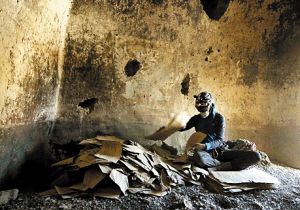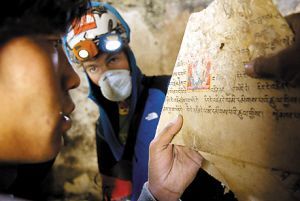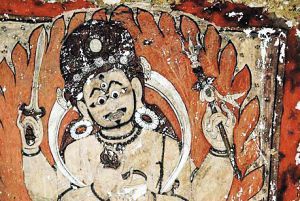Buddhist murals in ancient cliff caves in the Himalayas
A few days ago, according to the website of National Geographic magazine, the mountain climber Lena Oztuk entered the remote Himalayan cave in the ancient kingdom with an expedition and found a large number of ancient manuscripts.
During this expedition, they found a large number of paintings and manuscripts of Xizang in the 15th century, and the origami in Oztuk’s hand was one of them. These cultural relics can be associated with the source of inspiration of Shangri-La in the real world. In the novel Lost Horizon, which was popular among readers in 1930s, the British writer james hilton described Shangri-La as a fictional paradise.
Until recently, only a handful of people personally explored these mysterious caves dug on the steep cliff surface, because Upper Mustang is a forbidden area in Nepal and has been closed to outsiders for a long time. In 2007, a research team led by Broger coburn, an American researcher and Himalayan expert, and Pete assas, a veteran mountaineer, headed for the cliff where the rocks were peeling off and explored these artificial caves.
In two new documentaries, The Lost Himalayan Cave Temple and The Secret of Shangri-La, premiered by American Public Broadcasting Corporation on November 18th, 2009, the audience can see a series of treasures that they found during this trip and the second expedition in 2008.




The expedition found human remains.
During the exploration of Shangri-La Cave in Upper Mustang, Nepal in August 2008, the expedition team found some human remains. The man in the photo is assas, a mountain climber, who is staring at these bones. In 2007, assas and his colleagues discovered a Buddhist temple in Tibet, which was decorated with exquisite murals. Among them, a group of Buddhist murals consisted of 55 paintings, depicting the life of the Buddha. During the second exploration in 2008, the expedition discovered some human remains dating back to 600 years ago, a large number of precious manuscripts, and some small paintings as decorations.
Buddhist murals found in caves on cliffs
These Buddhist murals in remote Mustang caves were discovered in 2008, and they were carved in the steep cliffs above the Kaligandaki River watershed. Mark Turing of the Digital Himalayan Project of Cambridge University in the United Kingdom said that the Kingdom of Gumustan is called "the end of the world", which is full of vitality, profound cultural heritage and diversified religious beliefs.
A realistic version of Shambhala?
A 13th-14th century painting found on the wall of a cave in the kingdom of Gumustan depicts Mahagara, the patron saint of Buddhists in Xizang, that is, the dark sky. The cultural treasures found in Mustang caves mean that these places are related to the "hidden valley" that is believed to represent Shambhala, a Buddhist spiritual paradise. Many scholars believe that Shambhala has a corresponding place in the real world.
Coburn, head of the expedition, said: "These hidden valleys were born in the era of struggle, when Buddhist practice and leaders were threatened." In the novel of 1933, British writer Hilton introduced the concept of "Shambhala" to describe the lost valley of Shangri-La. Shangri-La is an isolated mountain area and a treasure house of cultural wisdom.
Precious religious materials
For centuries, although the Mustang Cave has not been spared from predators, coburn’s expedition discovered about 30 volumes of religious writing materials and collected some precious manuscripts from them. Coburn said that the cool and dry climate in mountainous areas provided a good environment for the preservation of ancient manuscripts, which included both Buddhist and local contents. This religion is an early indigenous religion in Xizang. Two religious writings show that after Xizang converted to Buddhism, the local people’s belief in this religion lasted for at least one or two centuries. Buddhism was introduced into Xizang in the 8th century.
Found human remains 600 years ago
A member of the expedition holds a human skull found in a remote Mustang cave in Nepal. In 2008, the expedition discovered human remains dating back to 600 years ago. The area where the remains are located may be a tomb, indicating that these caves were once used to bury the dead.
Collate the ancient written materials of Xizang.
In 2008, in one of the Mustan caves, Oztuk sorted out and classified a pile of ancient Xizang scripts. These manuscripts contain writings of Buddhism and this religion, which was a native religion in early Xizang. The expedition that discovered these 15th-century manuscripts believed that King Mustang did not choose to burn the books of this religion, but abandoned them in the cave, which was obviously a choice to show respect.
Turing of the Digital Himalayan Project at Cambridge University said that the discovery of these manuscripts may also be related to the tradition of Xizang people deliberately hiding religious works. He said: "These findings are obviously of great significance to the study of Xizang people’s traditions. People have discovered hidden manuscripts, or hidden cultural knowledge. These things may be lost or deliberately hidden. "